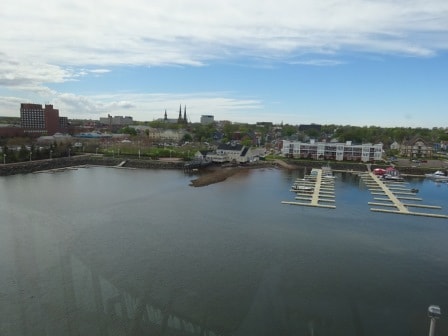I can see why the Scots of Scotland decided to settle down here and named the province Nova Scotia. It has the same weather as in the mother country. As today it was a day as if we were in the Highlands. Foggy, drizzling and with a cold wind blowing. It even came included with a bag pipe player on arrival; dressed in full Scottish gear. So it all felt real Scottish. We had an un-expected quirk in the proceedings as the ship received an email, saying that our berth was suddenly occupied by the Queen Mary 2; which was not supposed to be there at all. But the promise was that she would be gone before we came to the dock. It turned out that she had come in for a medical disembarkation while at the end of a trans-atlantic voyage. We were a bit amazed about that as normally the Canadian Coastguard loves to come out with their boats and do a medical disembark at the pilot station. So either they did not have a boat available or the patient would could not deal with the boat ride back in again. Saving lives always comes first and costs are not taken into consideration; but this must have been an expensive detour. Extra fuel consumption to make and keep the schedule, pilot, linesmen and docking fees and this during the night hours. No wonder the linesmen were in a good mood this morning, they had a good bonus night. We of course worried that the QM2 might not have left on time due to some un-expected complication but she did pull out 0700 and we passed each other just outside the port. Continue reading
Category: Canada & New England (page 3 of 4)
Contrary to various forecasts, the weather was quite good. Very good for Sydney for this time of the year. On the verge of going to summer, the weather is very unsettled and as a result the various weather forecasts can be completely different. In the vein of, is it partly cloudy, or is it partly sunny. Is the wind 20 knots or 25 knots or 15 knots? Thus a lot of wind was predicted today, while we did not really know if that prediction would come true and that makes Sydney a difficult port. If there really is too much wind then things are easy. The captain just cancels the port as it is not safe to go in. But if the wind force is on the edge of what is within in the safety margins then it becomes more complicated. Docking might be possible but will we be able to get out again in the afternoon? If there is not too much wind to go in but too much wind to dock, then dropping the anchor and using tenders might be an option. Not a nice option as it is a very long tender distance but it is an option to be considered. All this is going through the captains mind (and the rest of the crew) when approaching Sydney. Continue reading
We did not see any whales yesterday afternoon or in the evening, nor did we have to slow down on Coast Guard request. All was well in the world. It was even better than well, at least for the guests, as during the day the sun came through and this also promised a sunny day for Charlottetown. Which we had. It was less well for the navigators as sunshine in this area results nearly always in fog banks forming and this indeed happened in the late afternoon and early evening. But it is still early in the season so the banks are not that dense yet. But the moment the sun gains more strength it will be a daily occurrence. The ports will be clear and beautiful but outside where the warm air meets the cooler water, a white wall will greet the ship on each departure. That is the toll that captains and navigators pay so that the guests can have a sunny cruise in the Canadian Maritimes. But for now the balance is still ok, between good visibility and rain, and the amount of sunshine and VERY low clouds. Continue reading
During the night we were literally flushed out of the St. Lawrence River. When the river level is normal, e.g. all the spring water has drained away, the current going up river is about the same as the current going down river. And then we do not gain much as things balance out. But with so much water coming down the St. Lawrence, the flood tide has a real struggle to assert itself and the current up river, against us, is then not so strong. But when the tide then turns to ebbing, all the water that was sort of halted by the flood current comes down again as an avalanche. So for most of the night we had 5 or 6 knots of current with us. And that was a nice bonus but also a necessary bonus as navigating the river costs more time than in the past. Continue reading
It is not summer yet. Today it rained and it was windy and chilly. The locals call this weather Mavember. It should be May and spring like but the weather is providing a November day. And it is un-predictable. The ms Zaandam came down the river as scheduled and went under the bridge at 04.00 hrs. to ensure that the gap between radar mast and bridge was enough so there would be no “boiiing” when passing. And once past, the wind picked up from 15 knots to almost 30 and then with the current flowing strongly as well, docking becomes a complicated procedure. That wind was not expected as the weather was supposed to be stable all morning. For the afternoon, we had three weather forecasts with different opinions about the direction of the wind and the amount of rain. They did agree on the temperature. Continue reading
And so I joined today the good ship Zaandam in Montreal today. The Zaandam is one of the four R class ships, made up of the Rotterdam, Amsterdam, Volendam and Zaandam. Although one class, the Rotterdam and Amsterdam are real sisters and so are the Volendam and the Zaandam. Main difference is that the RTDM and the AMDM have different funnels and different propulsion and those two can sail a bit faster. This was done as they were in the beginning earmarked to do the long cruises, e.g. longer than three weeks and with ocean crossings. With the increase in fuel price in the mid 2000’s that idea wķent out of the window and all the HAL ships now sail at the most economical speeds possible. So the Zaandam is nearly identical to the Volendam which I reported about before I went on leave in May. For the guest, the difference between those ships is merely the décor and art inside the ship. The rest is behind the scenes where localized “creativity” by the ships complement and/or different dry dock refits resulted in some minor operational differences. Continue reading
With sunrise at 06.00 and a hazy sky we serenely sailed over a flat calm Mediterranean and then into Santorini. The hazy sky was courtesy of the lack of wind today but it all cleared up by 09.00 hrs. when the sun burned it off. The high pressure system over the Balkans which causes the winds in the Aegean Sea is not yet permanently in place (they also have cloudy days on the Pusta’s) and thus it was wind still, yesterday and today. The captain had opted to come in via the South West entrance and then sail north to our “floating area”. The Celestyal Spirit was already at anchor on the hump as she is larger than the Ovation in guest capacity and makes more calls but still small enough to leave plenty of space to come close to the town. Sailing into Santorini is always interesting as parts of the outer Crater wall loom overhead and the black core creates a sort of round-a-bout where the ships have to sail around to get wherever they want to go. Continue reading
Just after midnight the water and air temperature got in balance and a white cloud descended over Northhumberland Strait. This is the stretch of water which separates Prince Edward Island or PEI from the rest of Canada and as the Maasdam was in the middle of that Strait we did not see anything anymore. And so it remained until arrival. Looking at the positive side it meant, no more rain but sunny periods during the day, even if it was chilly. Steam was coming off the aft swimming pool and that you only see when it is chilly, cold or freezing.
Charlottetown is the largest town on the island and has grown around three rivers which all dump their water in the harbor area. It has a nice Cruise ship dock, long time ago inaugurated by yours truly with the Veendam when it was transformed from a small cargo dock into something which the locals can be proud about. The town is named after a British Queen – Consort of King George III (Although she herself was German) and it has the claim to fame as being the birthplace of the Canadian Confederation. In 1864 the Charlottetown Conference was held here with the aim to unify the area which we now know as Canada.
Sailing into Charlottetown can be quite spectacular as the ship sails into a sort of lagoon with cliffs on both sides. These cliffs are of a red clay type material and give the area a very unique view. The port itself is located in the back and quite nicely sheltered. If there are more cruise ships in port then there is also an anchorage and that is less nice. The three rivers converge here and there is the tide. In total four forces of current hitting the ship at anchor. At a normal anchorage the ship swings around on the tide and then settles with the bow into the flow. Not here as the resulting influence of those four forces constantly changes and keeps pushing the ship one way or the other. It is constantly swinging around the anchor and it never settles. I have been here at anchor only once (and that was more than enough) and during a four hour period (without a change from Ebb to Flood) the ship made three complete turns around the anchor. It only settled to some extent when the wind picked up; but we do not like that either as it means a choppy ride for the tenders. Luckily normally Holland America Line ships dock as we have been coming here as one of the first cruise companies and are very regular in our calls. In some ports seniority still counts for something.
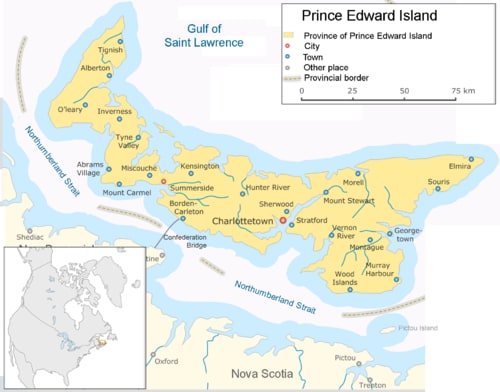
Prince Edward Island. The Confederation Bridge location can be seen on the lower left. (Courtesy Wikipedia)
On the island there are plenty of things to see and do and some of the tours also go off the island as there is a bridge connection with the mainland. The Maasdam will sail under it tonight and it takes about 3 hrs. from the dock to get there. It saves quite a few miles to take this route as otherwise you have to back track and sail around the whole of the East side of PEI.
Sailing under the Confederation Bridge is a mixed blessing. It is very nice to do and quite spectacular as the old Westerdam just fitted under it but the area is full of lobster pots and as lobsters do not tend to pay much attention to steamer routes, the fishermen tend to have the same attitude and set the pots wherever the lobsters might be. If one is in the channel then we can sail around it and then there is a chance the rope between the lobster pot and the indicator buoy at the surface might get in the propeller. To avoid damage we have little knife tips permanently attached to the inner edge of the propeller to cut the rope before it hits the seal. Especially plastic fishing lines can cut into the seals of the pitch propeller blades and can cause oil leaks. Although the hydraulic oil we use is environmental friendly and does not pollute the environment, we still do not want leaks.
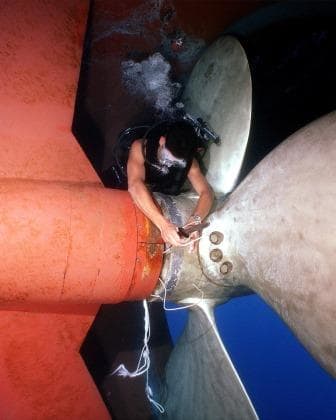
One way of getting the ropes out is by diver and we have to do that some times. We have little knife blades at the rim of the propeller end, exactly where the diver has his hands & knife. (Photo courtesy website osd.dtic.mil)
This evening we sail at 1800 and head to the St. Lawrence Pilot station and then tomorrow we will spend the day on the river, heading towards Quebec. Weather for tomorrow chance of rain and chilly, if it will bring haze, we will see.
Sydney can be a horrible place if the weather becomes inclement and its location gives a lot of options for it to do so. Winters are harsh with North Easterly winds and when there is mayhem coming from the North Atlantic to the East then it also gets it. When they designed Nova Scotia they forgot to put a high mountain range on it and thus nothing shelters Sydney very much. On top of that its port is located in a sort of pond where even a medium size cruise ship cannot swing around in. Let alone a big one. Thus we have to swing off the cargo terminal and then go astern for half a mile. We love going to Sydney but we like nice weather when we do so.
This morning we had it and with the sun shining brightly and hardly no wind at all the good ship ms Maasdam sailed without any concerns into Sydney Bay, swung around and went astern to the dock. We prefer to go stern in, so the nose is pointing to the direction of the sea. Always easier to give full ahead and racing away from bad weather in the port than having to struggle and swing with the wind full on the beam. So a wise captain always docks with the nose towards sea when feasible.
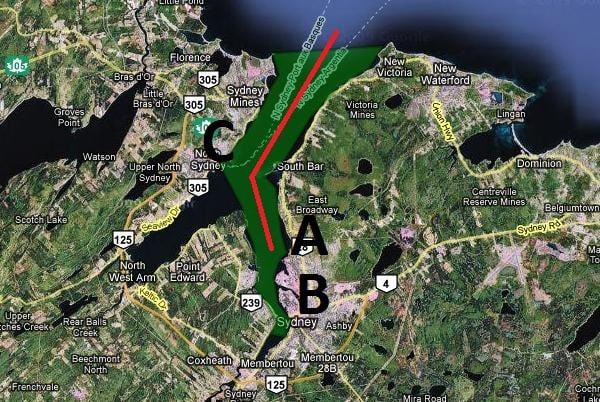
The red line is our course and where it stops is where we swing around to get to point B, the port at the narrow part. (Photo courtesy of Sydney Harbour)
The pilot boards outside and then sails the ship in, until we come to point A. There the captain (Or his designate, thus it was the Staff Captain this morning) swings the ship around and then goes astern to point B where the dock is. The dock is at the end of a sort of Fjord and there is only one way out and that is why we like the ship to already point that way. I marked the map also with a point C. This is the west side of the entrance and here a lot of erosion takes place. Sand is deposited by the sea at the East side and eroded away at the west side. This has been going on for a while and the last time it was threatening the church with its grave yard, which in the years before had already lost some tombstones (and its inhabitants)
The weather forecast predicted inclement weather in the afternoon and that indeed happened. By 13.30 it started to get overcast and the wind picked up. The rain was coming which we had been outrunning thus far. By 16.00 hrs. just before departure there was 30 knots of wind and with rain showers already visible in the distance behind the ship. Halifax had had a good downpour in the morning and Sydney was the next one in line for some wet appreciation.
But for the guests, most of the day it was a very nice day and those not on tour walked into town. Sydney’s main street is quite close to the ship and a regular provincial town with some sort of a “border” flavor to it. There is very good Pub and Restaurant opposite the ship so I might be tempted during our next northbound visit to walk over there as (according to the ships agent) they have a nice variation of local Craft/draft beers there. One should always be interested in local culture, especially if you can drink it.
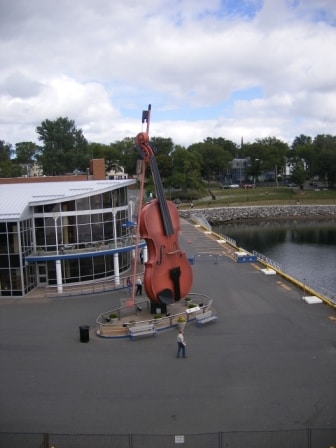
Sydney also considers themselves the Fiddler Capital of the World and that cultural achievement is proudly displayed by having the largest (?) fiddle in the world on the cruise pier.
Today was ship inspection day which means I walk each deck and check each nook and cranny. It left enough time though to run ashore for the Staff Captain and buy a new TV for training purposes. The old one in the Bo ‘sun Store had a faulty PCB and according to our TV expert on board ordering a new PCB was almost as expensive as being a new one. As with every large company, we have a certain amount of Red Tape to deal with and ordering a new TV via the regular procedures might take three months. But the Training Dept. In Seattle also has a small contingency fund for emergencies and they agreed that I & the ship had such an emergency.
A big store with a big Blue and Yellow sign was selling TV’s but was also the only store in town which did not accept US dollars so I also had a cultural outing to the bank of Nova Scotia where a very nice Lady calculated how much USA I needed to change to pay a Canadian bill. Canada (or at least Sydney) has a recycling surcharge on electric goods. I am all in favor of that so I paid another 35,– to ensure that the tv will be properly recycled. Only thing is that it will probably break down somewhere in the South Pacific and never come back to Sydney. If it would do so in the South Pacific maybe we could land it in the other Sydney and say we already paid a recycling charge…………………..
Tomorrow we are in Charlottetown where we hope to be docked by 09.00 hrs. According to the weather guru’s the rain clouds should have shed their full loads on Cape Breton Island and Charlotte town is only supposed to be overcast with temperatures around 63o F / 17 oC. not bad for the month of May.
We left a little late from Bar Harbor as the tours were delayed which is sort of normal. Something to do with traffic somewhere along the route. As a result we just made it on time to Halifax but it took a while to get the gangway lined up (first time of the season) and thus a real avalanche of eager shoppers burst out of the ship once the ship had been cleared. The lone piper who welcomed us into port was drowned out by noise caused by the stampede going down the gangway. I have never seen a ship empty itself out so fast as today. But then it was a gorgeous day with the sun brightly shining, no wind and still having cool temperatures which kept the haze away from spoiling our visibility.
Thus very quickly the large majority of the guests were gone and the rest trickled off the ship shortly after. A good thing as well, as at once controlled mayhem was initiated by means of our weekly fire and boat drill. Regulations are getting tighter and tighter, based on incidents and past experiences and that is reflected year by year in the increase of the intensity of our drills. All very much with my blessing; as in my humble opinion you cannot train enough. And if I could get away with it, then I would have everybody messing around with fire extinguishers and fire hoses and everybody would be proficient in driving and commanding a lifeboat. Maybe in the future that will happen, now crew specializes in certain duties and that works as well but there is always room for improvement.
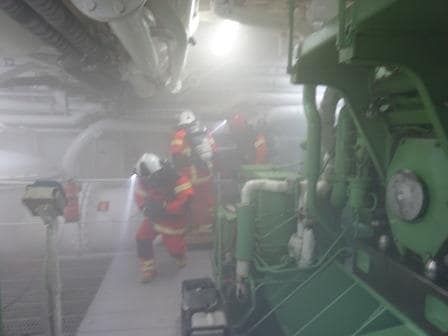
A ships firefighting team coming around the aft end of Main engine nbr. 5 In real life the smoke would be black from burning fuel but we can not simulate that so we use white stage smoke.
As a result of the regulations and the way they are interpreted, it means that every crewmember has to attend a fire drill each week and each crewmember has to attend a boat drill every month with instruction and exercise. We cannot have all 600 crew of the Maasdam running around with a fire hose so for most of them assembling and getting ready is enough. Thus with every weekly drill we now have the whole crew on the move. And that goes as follows:
- We sound the First Stage Emergency alarm because there is an emergency, normally a fire.
- This means the firefighting teams assemble and exercise. Today we put engine number 5 “on fire” and drilled all the procedures for extinguishing it again. About 100 people are involved.
- The captain gets concerned about how the “if we can extinguish the fire or if we cannot”. He orders to sound the crew alert alarm and all the crew is now on the move. The majority of them report to their assigned stations ready to support the guests. Those with non-specified functions report to the crew mess room and wait for further instructions.
- The captain is now getting really concerned and wants everybody at the lifeboat station, just “in the case “. We ring the General Emergency Alarm and simulate that the guests have already reported to their lifeboat stations and now the crew can follow. The crew in the ship gets dismissed by groups and starts to appear on deck. The more critical the function is, the longer they have to stay where they are. So the firefighters are normally the last ones to appear on deck.
If things go so far that we have to abandon ship, then the sequence continues with announcements over the outside P.A system as everybody is on deck anyway. Guests are sent away in the lifeboats and the crew follows in the life rafts. The last person to leave is the Captain who will only leave the ship when he absolutely sure it will not survive.
Not all the crew has to stay on deck for this whole procedure, as soon as everybody has been accounted for, 75% is dismissed and the remaining 25% get their monthly training. So during the required monthly period everybody will be trained, refreshed and kept alert.
While this is going on, vital activities have to continue such as bridge and engine room watches but also preparing for lunch. Thus there is a rota for that crew to get excused for one of the four monthly drills. The whole sequence normally takes 60 to 75 minutes and today we were all quite happy because outside it was such nice weather.
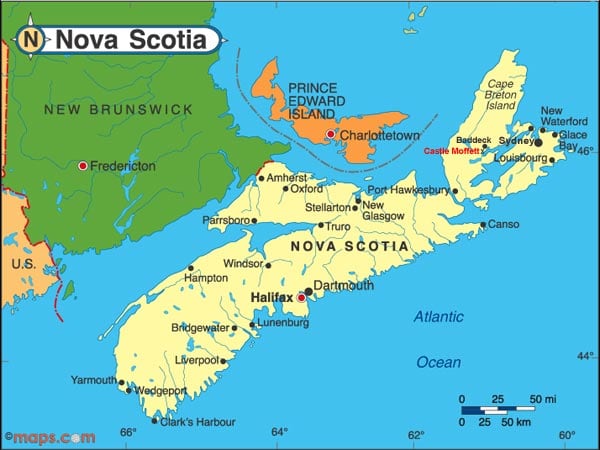
The route from Halifax on the soutside of Nova Scotia to Sydney on the North side of Cape Breton Island. Map courtesy: www.maps.com.
Tonight we will sail around the northwest corner of Nova Scotia, what is called Cape Breton and then we will be in Sydney by 11.00 hrs. which is located on Cape Breton Island. We are still out running the rain, but it will catch up with us in the late afternoon. Still there is no wind expected and the temperatures should be around 61oF or 16oC which will make it quite pleasant.
© 2025 – Captain Albert's Website and Blog –
Theme by Anders Noren — Up ↑
